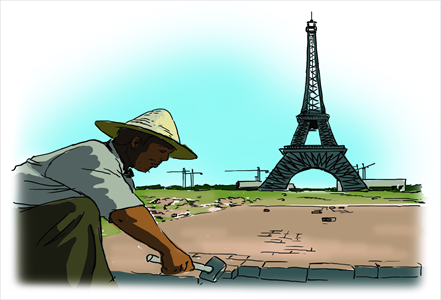Copycat buildings just a symbol of aspiration

I have a friend who lives in a remote Beijing suburb that, at first glance, might easily be mistaken for a small US town. One building even has a replica church tower, perched over the compound management office. As a recent story in the UK's Daily Mail points out, this kind of imitation Western atmosphere is becoming increasingly popular in China, from Shanghai's mock-UK "Thames Town" to full-scale replicas of Western landmarks.
Writing in Foreign Policy magazine, Jack Carlson puts forward the peculiar theory that these buildings are a symbolic representation of Chinese arrogance and imperialism, arguing, "By appropriating the monumental trappings of power from distant places and times, the Chinese do not merely place their own country on a symbolic par with historical Western superpowers, but suggest that China has mastered and transcended their levels of achievement."
Carlson cites historical examples, such as the vogue for Western styles during the Qing dynasty (1644-1911), and the building of imitations of sites in Vietnam, Korea, and elsewhere that Chinese troops conquered throughout the centuries.
Carlson's piece is typical of a certain style of analysis that constantly looks for sinister implications and overarching motives in China, ignoring the everyday incentives that actually produce such projects.
He ignores the obvious difference in his stretched attempt to draw a parallel; these developments are not being mandated or directed from the central authorities, but by private developers or, occasionally, local officials. The driving force is the market.
The copycat buildings represent not, as Carlson sees it, triumphalism, but aspiration. Ordinary Chinese still aspire to the European or US lifestyle. The vision of roomy houses, gardens, pleasant streets, and clean air is one that middle-class Chinese long for, and a powerful reason why so many still look to take their families abroad given half a chance.
Pseudo-US suburbs in Beijing or imitation English towns in Shanghai give them a chance to realize this without the inconvenience of visas or money transfer.
Then there's the obvious motivation of cost. As with electronics firms turning out cheap copycat products, it's a lot easier to steal an existing design than to try to create your own. Even successful Chinese designs are widely stolen by other cities or firms, given the looseness and difficulty of enforcing intellectual property rights.
And where officials are involved, the motivations are far more practical than symbolic victory over the West. The first reason for these imitation projects is vanity projects; an official on a short-term posting looking to make his mark. These are common throughout small cities and towns, and the quick-and-dirty copying of a Western building is an easy way for a local official to point to his "achievements."
Another reason is more practical. Small Chinese towns all pretty much look the same, and often have little to attract tourists.
While some may look to the past, claiming to be the birthplace of a historical hero - often in competition with several other towns claiming the same - others build imitation Eiffel Towers or Gundam statues in the hope of providing something to draw tourists. It's the same spirit in which midwestern towns in the US boast the World's Largest Doughnut.
These imitations, pleasant as some may be, are still deeply regrettable. Throughout the process of modernization, many Chinese have become used to imitating other countries. At first, the Soviet Union was the model, producing the grim block-buildings of the 1950s, which look the same in Beijing as Budapest. Since the 1980s, it's been the West.
There's little attempt to find ways of living and building that would offer a way of being both modern and Chinese, partially because of the massive loss of heritage in the Cultural Revolution (1966-76) and earlier.
Instead of attempting to renovate traditional buildings, or to create residences or public spaces that would reflect China's wealth of historical architecture, Chinese cities are throwing up cheap imitations of the West. The public, and the past, deserve better.
The author is a copy editor with the Global Times. jamespalmer@globaltimes.com.cn